What is inside that B-Pillar? Can it be sectioned? Must I do pre- and post-repair scans? The answers to these and other questions can make or break your repair, and are all in the Body Repair Manual and other sections of the Nissan service manual.
 Nissan publishes a large number of repair service manuals, accessory installation instructions, owner’s manuals, technical service bulletins, training documents and other informational materials applicable to all of its vehicles. Much of this published information is available for online viewing, if you have a subscription. Some publications must be purchased separately.
Nissan publishes a large number of repair service manuals, accessory installation instructions, owner’s manuals, technical service bulletins, training documents and other informational materials applicable to all of its vehicles. Much of this published information is available for online viewing, if you have a subscription. Some publications must be purchased separately.
Available for purchase separately is diagnostic software to use with the Nissan CONSULT III Plus (or other full-featured scan tools) and J2534-1 compliant software for reprogramming Nissan engine and transmission control modules.
In this article, we’ll discuss the “Online Subscriptions†option, which includes access to Nissan service manuals, body repair manuals, training modules, owner’s manuals, and selected technical service bulletins and tech tips. One subscription covers Nissan vehicles from 1989 to the present.
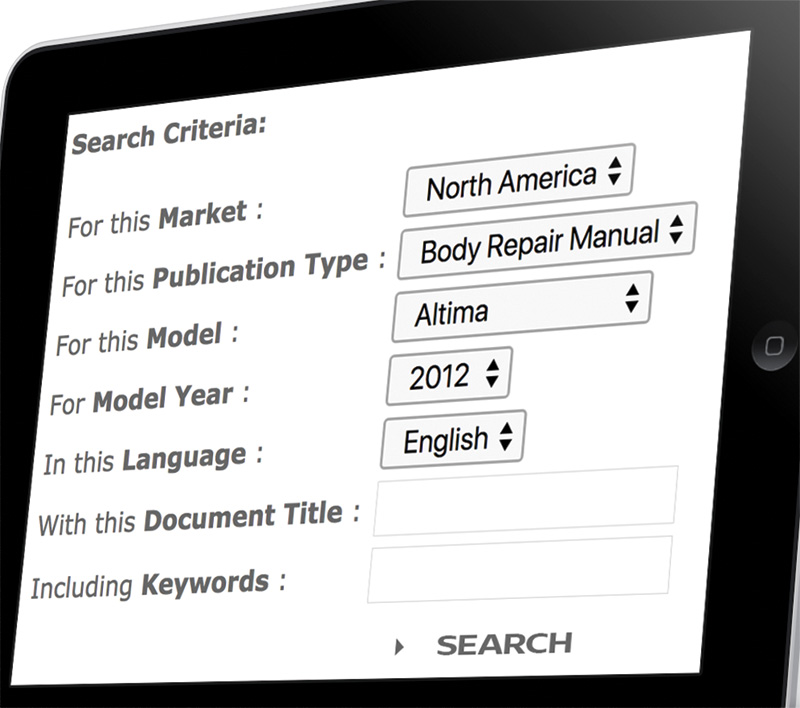
To search for a body repair manual for a 2012 Altima sedan, go to the “Search Publications†screen, select “North America†as the market, and “Body Repair Manual†as the publication type. Select “Altima†in the “For this Model†box, “2012†in the “For Model Year†box, and “English†in the “In this Language†box. For now, leave the “Document Title†and “Keywords†boxes empty (this will not reduce the effectiveness of your search).
Getting started
- Go to the website: nissan-techinfo.com
- Select the country you are in by dragging your mouse to your country or region on the global map, and clicking or pressing ENTER when the correct country or region becomes highlighted in red.
- A new window will open, showing options to view Nissan publications, view technical service bulletins, access diagnostic software, and use other Nissan resources. Access to accessory installation instructions, navigation system manuals and owner’s manuals is free, while other resources are subscription-based. A list summarizing the available Nissan technical service bulletins is also free, but you’ll need to subscribe in order to view a TSB in its entirety, or download a full PDF version. If you are not yet a registered user, you first need to register. Drag your mouse to the “Purchase Subscription for Viewing Publications†box until it is highlighted, and press ENTER.
- An “Online Subscriptions†window will open. To see a list of products you may purchase, click on the “Select One†drop-down arrow. Your choices will include Service Manuals, Technical Service Bulletins, training modules, plus additional Nissan publications. You can click on each option to see a description before you purchase. If you have any questions, a help menu is always one of the tabs that run across the top of each screen in the Nissan-techinfo.com website.
- Click on the “Online Subscriptions†link. A new window will open showing (near the bottom of the screen) the online subscription rates. You can subscribe for as little as $19.99 for one-day access, $75.00 for one month, or up to $720 fora full year. Have your credit card ready, and click on your choice. Once you complete this step, you can begin using the Nissan-techinfo.com website.

The Nissan Body Repair Manual is a subsection of the service manual for a given model or chassis family. It is found in the “Body Exterior, Doors, Roof & Vehicle Security†group, which is Section K in the Quick Reference Index (table of contents).
The Nissan Body Repair Manual is a subsection of the Service Manual for an individual vehicle model or chassis. To find the Body Repair Manual for any Nissan model, start by finding the service manual for that model.
A “Search Results†window will open, showing the titles of the Nissan Service Manuals it located for you. There may be more than one publication, based on different body styles such as sedan, coupe, or cabriolet, or alternate drive trains (hybrid, etc.) within a model line. Separate wiring diagram publications may also be listed here.
Icons to the right of the title will indicate whether you can view the document online, purchase the document on CD or DVD, or purchase a printed (book) version of the document. Click on “View this Book Online Now†to see the service manual.
What Nissan calls a “Quick Reference Index†will open. The index will be divided into groupings of key vehicle systems, such as engine, transmission & driveline, suspension, steering, body exterior & vehicle security, body interior and others. Each title in the right section of the index is a clickable link to the listed repair manual section. When you click on the “Body Repair Manual†(BRM) title, the document will open and you will be able to read it online or download it in a PDF format that you can save on your computer hard drive.
Click on the “Body Repair Manual†title. The Body Repair Manual (BRM) will open. It contains 106 pages of repair information covering the body exterior, doors, roof and vehicle security. Inside you will find step-by-step replacement procedures for the front assembly, hood, front side member (rail), front and center pillars, door sills, rear quarter panel, fender, rear floor, rear side member and other components.
There will be information about exterior paint color, corrosion protection and body sealing methods, and working with high strength steel (HSS) and plastic parts. You will be able to access body dimensions, the locations of body alignment marks for various vehicle sections, and instructions for how to make measurements to ensure repair accuracy. You will also find precautions about working with air bag and seat belt pretensioner systems. And you will see all of the above information in application-specific sections for each of the sedan and coupe versions of the 2012 Altima.
Two body repair information subgroups
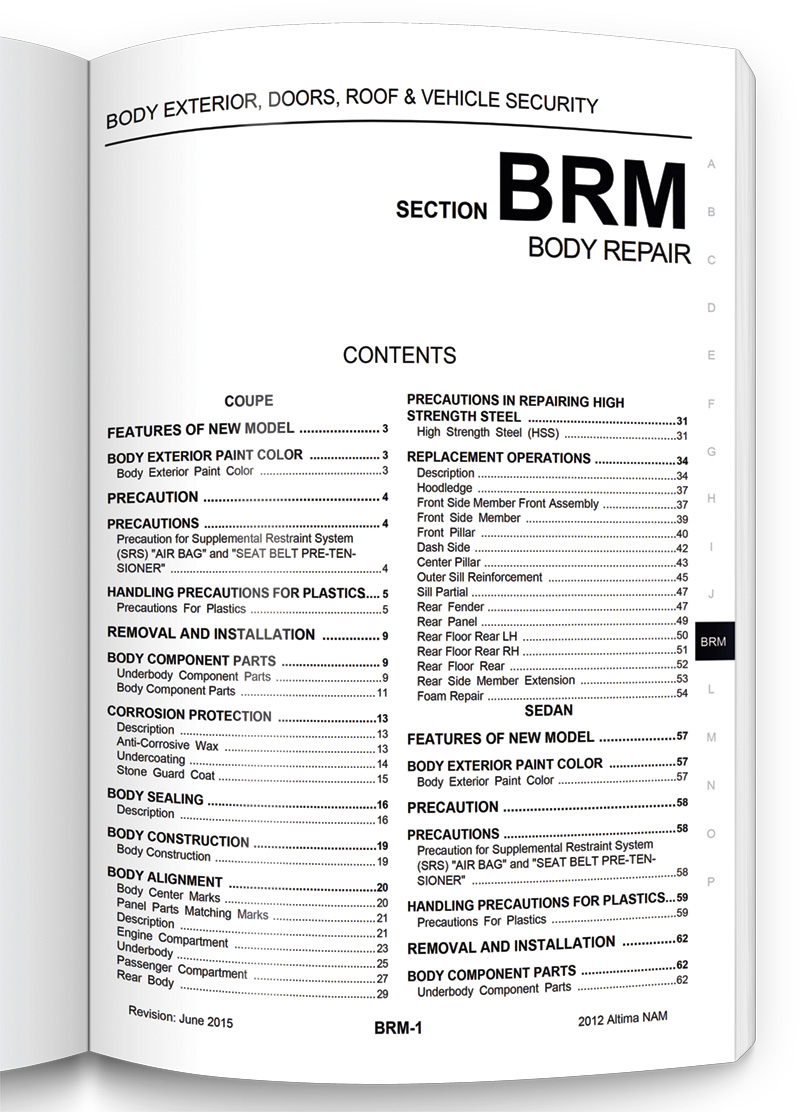
The 2012 Altima Body Repair Manual contains 106 pages of repair information covering replacement procedures for the front assembly, hood, front side member (rail), front and center pillars, door sills, rear quarter panel, fender, rear floor, rear side member and other components.
Nissan publishes BRM information in two different sections of its service manuals. First, there is a “Body Repair Manual – Fundamentals†section. It provides general information applicable to most Nissan body design implications for collision repair. It discusses the different types of body materials used, including advanced steels, aluminum, and plastics, and their impact on your repair or replace options. It mentions the special precautions that must be observed when working with each material type.
It offers explanations of welding methods that are approved for Nissan vehicle repair, body straightening equipment and techniques, and panel partial replacement (sectioning) guidelines. It includes extensive detail about repair of high strength steel (HSS), aluminum, plastics, and windshield or window glass.

In a front hit, impact is absorbed at the circled portions of the body. If it is not absorbed completely, impact damage can travel to the dash panel and roof.
The BRM-Fundamentals section includes explanations of basic principles that apply across the Nissan model line. For example, if an HSS or Ultra High Strength Steel (UHSS) component such as the front side member outrigger assembly/rear extension (HSS), the rear side member assembly (HSS), the inner sill (HSS), or the front floor (UHSS) is cracked or broken, replace the assembly.
The Fundamentals section explains collision impact and where to look for direct and indirect damage based on the impact area and direction. For example, it shows how impact forces travel through the vehicle, and what structural components are designed to give first in an accident. Some of those components may be hidden behind other parts, or under a cowl or panel. Paying attention to the Nissan system descriptions and repair procedures alerts you to specific areas you should include in your collision damage inspection, based on where the vehicle was hit.
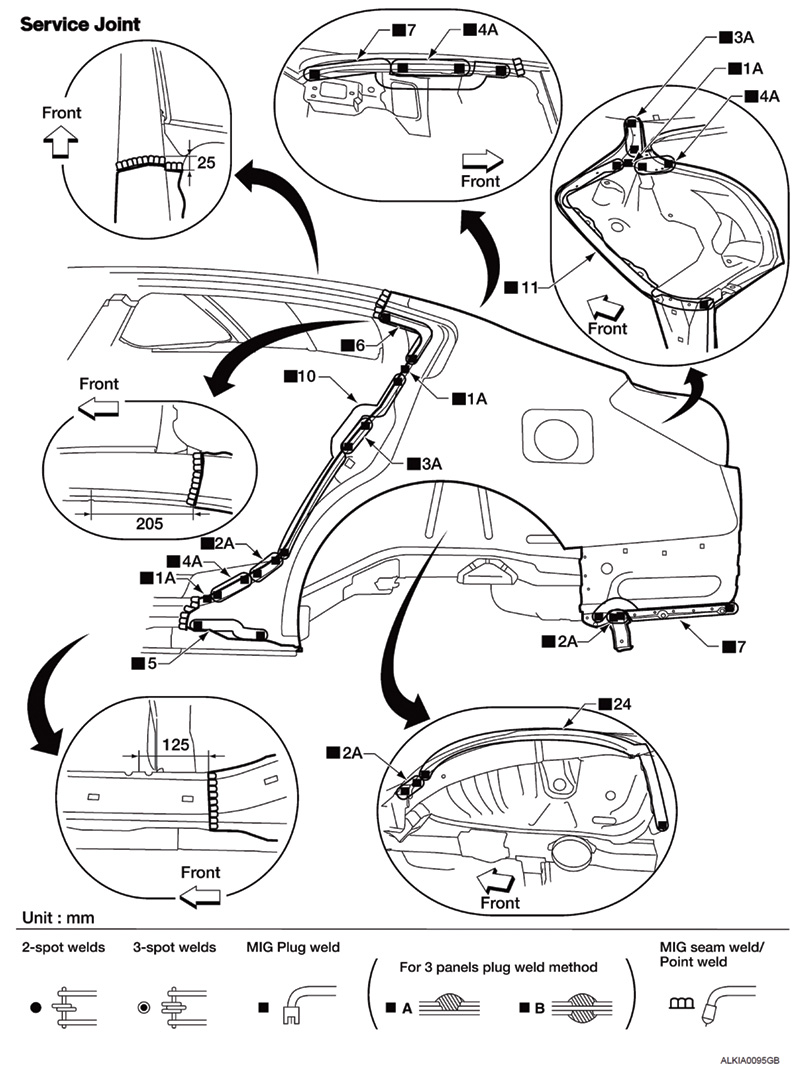
In one image, Nissan shows a large amount of information needed to replace the rear fender on a 2012 Altima sedan. It includes cut locations for replacing the fender, and explains that the cuts are MIG seam welded, that MIG plug welds are used in many other areas of the repair, that many are 3-panel thickness, and that almost all are plug welded from one side only. The key across the bottom of the image shows symbols that represent each different weld type used in the repair.
Don’t forget to itemize on the estimate any digging you had to do to find hidden damage. If the damage wasn’t obvious in a preliminary walk-around with a claims adjuster, you can include with your estimate a link to the Nissan repair procedures that require the additional inspection steps.
You can find the Body Repair Manual – Fundamentals section in the Search Publications menu by listing “Body Repair Manual†as the publication type, leaving the model and year boxes blank, and typing “Fundamentals†in the “Document Title†box.
Second, Nissan includes a Body Repair Manual section in the service manual for each vehicle platform or chassis series. That section will include repair procedures that are specific to the Nissan models and body styles in the individual service manual. For example, the Body Repair Manual in the Service Manual for the 2012 Altima covers both the coupe and sedan, gives application-specific step-by-step repair procedures, and provides detailed illustrations showing what you will see as you disassemble and reassemble the vehicle. Access to both the Service Manual and the Body Repair Manual is included when you get an online subscription to Nissan publications.
General versus application-specific tips
The difference between the BRM-Fundamentals and the BRM is that the Fundamentals section gives general body repair principles, with examples for demonstration purposes, while the BRM gives specific repair procedures for a given component and Nissan model.
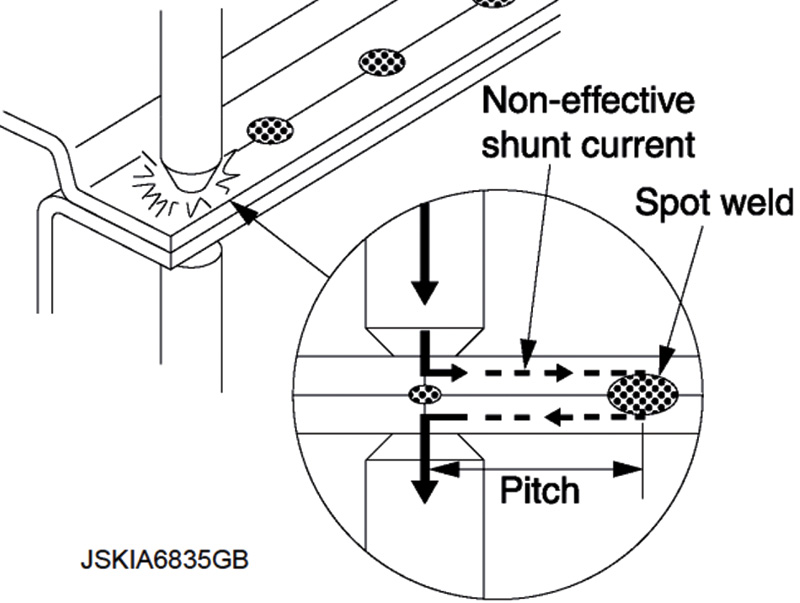
The BRM-Fundamentals manual explains the general principle behind the recommendation to avoid an excessively small pitch between spot welds (inadequate pitch allows current to flow to the nearest welds, reducing weld strength).
For example, in the BRM-Fundamentals you learn that you should not place spot welds too close together, because some current will bleed off to the nearest weld location, weakening the intended weld. In the BRM for a given Nissan model, you get the exact pitch recommendation, weld tip diameter, pressure, current, and weld time for the joint thickness and number of plates being spot welded.
In the 2012 Altima BRM you will find a section entitled “Precautions in Repairing High Strength Steel.†It contains important information about the maximum temperature tolerated by the HSS used in the 2012 Altima, procedural tips for use when straightening HSS, how best to drill and cut HSS panels, and when and how to use MIG versus spot welding. It will also tell you the exact pitch distance to use for the thickness of the joint being welded.
The Fundamentals section also explains measurement procedures, shows the symbols for frequently used Nissan measurement points, and provides examples of the locations of measurement points for various structural components and body panels.

When welding HSS panels on the 2012 Altima sedan, use spot welding whenever possible in order to minimize heat-related weakening of surrounding areas. Select the electrode tip diameter and welding pitch (center-to-center distance between welds) based on the metal thickness of the joint being welded.
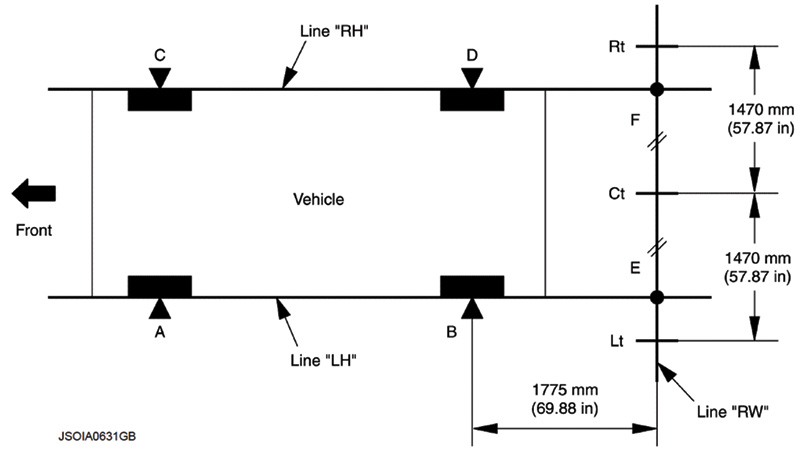
Once you set up the targets and input the rear view camera height to your CONSULT III Plus, select “Rear Camera ITS†and press “Start.†CONSULT III Plus will take you through the process of aiming and verifying the camera calibration.
Nissan collision repair Position Statements
Nissan has issued a series of official collision repair Position Statements that state the company’s requirement that specific procedures be followed when repairing or replacing parts of the vehicle that contain electronic or electronically-controlled components. A sensor that is embedded in a bumper cover or body panel needs to be aligned to the proper horizontal and vertical coordinates so that it points where it should to “see†the intended target area around the vehicle. Nissan has developed targets to assist you in adjusting or verifying that a sensor is aimed in the right direction. But first you must install the bumper cover, body panel, or mounting bracket to meet factory-specified dimensions so it is positioned to point in the right direction.
Nissan has issued position statements that explicitly state how certain repair procedures are necessary to the restoration of specific safety-related technologies to proper functionality. Some position statements require using only genuine Nissan replacement bumper covers, windshield glass, and other parts, because off brands have not been tested and verified to offer the precision fitment needed to ensure that embedded sonar, camera or other detection technology is properly positioned. It also mandates that body filler or paint not be allowed to cover or be too close to the blind spot warning or other sensor in a bumper cover or panel.
Additionally, many of these electronically-controlled devices need calibration or re-initialization after any remove-and-replace procedures. This includes camera and other sensors in the Around View Monitor, Blind Spot Warning, Intelligent Cruise Control, Forward Emergency Braking, Seat Belt/Air Bag, and Steering Angle Sensor systems. It also includes the controllers for the Power Window System, so the up/down and auto-stop features work properly. Nissan has issued a Position Statement about the requirement for pre- and post-repair scanning to identify up front which electronically-controlled components may need repair or replacement, and then to verify post-repair that your work successfully restored the system to its proper functionality.
You can find additional details about proper repair procedures for these safety-related sensor and control technologies in the Driver Assistance System (DAS), Cruise Control System (CCS), Power Window Controls (PWC), Glass & Window (GW, for devices embedded in windshields), Seat Belt (SB), SRS Air Bag Control System (SRS), Steering Control System (STC) and other sections of the service manual for the Nissan model you are repairing, if it is so equipped.
Go to http://collision.nissanusa.com to access copies of Nissan collision repair Position Statements. Scroll down to the bottom third of the screen and you will see a “Position Statements†link. Click on it and a list of links to each position statement Nissan has issued will open. Click on any title and a PDF copy of that position statement will open. You will be able to download a copy, save it to your hard drive, and print it as needed to show to insurance adjusters and vehicle owners.
The collision repair information you need is in the body repair sections of the Nissan service manual. Dig in!
Â

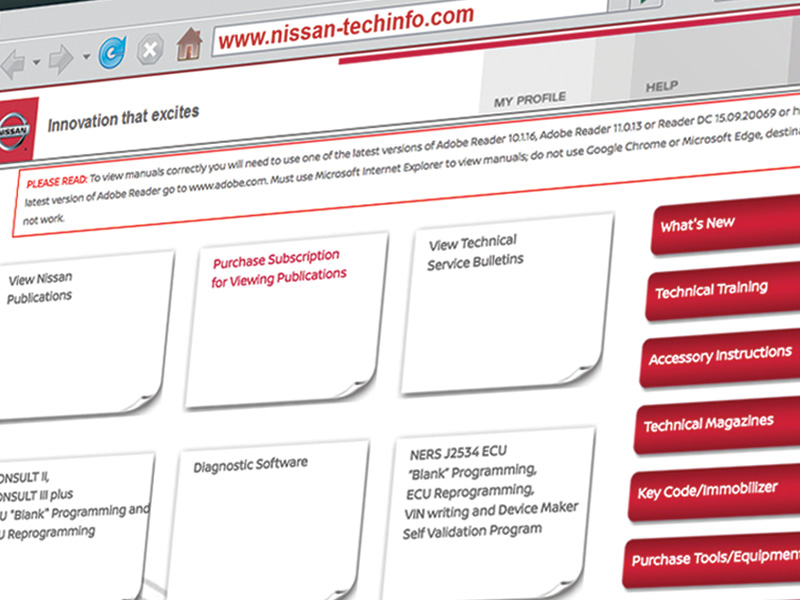




0 Comments